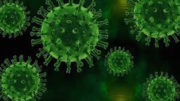Justin Kipness is a senior planning to study biology at Brown University in the fall. Each week, he will trace the Coronavirus pandemic from its origin in Wuhan, China all the way to Stamford, CT. See Part 1, Part 2, Part 3, Part 4, and Part 5 to learn how we got here.
The Virosphere
Disease ecologists are the modern epidemiological explorers. During the SARS outbreak of 2003, researchers trekked through the wet markets of Guangdong and remote civet farms. Once the AIDS pandemic began unravelling, researchers took samples from chimpanzees at Gombe National Park in Tanzania (the same place Jane Goodall famously studied them!). Scientific explorers take animal specimens to look for live viruses, viral genetic material, antibodies, or any other clue that signals the presence of the infection of interest.
In the time of a zoonotic viral outbreak (one that emerges from animals), scientists are always eager to discover the source. The purpose of finding the source goes way beyond scientific curiosity. Pinpointing the origin host can allow researchers to collaborate with officials to eliminate possible routes of viral spread.
There are two types of hosts scientists worry about in a zoonotic outbreak: the reservoir host and the intermediate host. The reservoir host is the animal the virus originates in, usually without causing disease. The intermediate host is the animal that gets infected by the virus from the reservoir and then transmits the virus to humans. Identifying and minimizing our contact between these two types of hosts can reduce new emergence of the virus in the human populace.
Although the first recorded human infection was in Wuhan, China, the first animal infection by the severe acute respiratory syndrome coronavirus 2 (SARS-CoV-2) remains elusive. This leaves scientists with many important questions: what species was first infected? Where did the first spillover of the virus occur? What type of host is the virus’s reservoir? Are there intermediate hosts?
There are many hypotheses regarding the origin species circulating the scientific community and society. A popular one is the bat: a likely candidate due to its killer track record, from rabies to Hendra virus to SARS to MERS to Nipah virus and maybe Ebola virus (although like SARS-CoV-2, this is not proven).
The vast scope of ecological systems such as Asian forests makes it impossible to test every animal for viral presence. The task becomes even more daunting when you consider the globalized animal trade bringing exotic species into wet markets. Before scientists can even think about finding definite answers to the questions above, one more important question needs to be asked: how can scientists, experimentally, determine the host?
The answer to this question first involves identifying possible hosts. In labs, molecular biologists and virologists perform experiments to try and pinpoint likely reservoirs and intermediate hosts. Once these species are determined, ecologists then can go into the forests, markets, and farms, among other places, to take animal samples. If their data is accurate and they have a little bit of luck, they may just find answers.
The story of this pandemic again takes us to a biology lab. One lab studied viral phylogenetics – a fancy way of saying they look at how viruses are evolutionarily related to one another. When the lab attained samples from coronavirus patients, they extracted the genome of the virus and imputed it into a database.
The bat cave expedition amongst the rice fields and mountains of Yunnan Province (as discussed in Part 2) comes full circle. During investigations like these, scientists isolated unique coronaviruses from bats or other animals, many of which were taken for sequencing and placed in the database. Therefore, when the scientists during the current outbreak inputted the novel human coronavirus into the computer, there were other viruses to compare it with.
The phylogenetic tree they constructed was attached in the paper published in peer-reviewed science journal Nature. The closest branch to the human coronavirus on the tree would represent the virus that it was evolutionarily closest to. It hinted that the novel coronavirus could have evolved from that virus or a common ancestor of the two. The paper in Nature showed that the closest branch to what is now known as SARS-CoV-2 is a branch containing the virus BatCoV RaTG13, a bat coronavirus. More specifically, it is a coronavirus from the species Rhinolophus affinis – a type of horseshoe bat found in Yunnan, the same province in which Professor Zhengli Shi conducted her study discussed in Part 2.
The study in no way proves that bats are the reservoir but hints that a bat coronavirus could have evolved into SARS-CoV-2. The phylogenetic tree also does not reveal that BatCoV RaTG13 is the most genetically similar virus to the one found in humans; it is simply the most similar as far as we know. BatCoV RaTG13 has about 96 percent sequence identity to SARS-CoV-2, according to the paper published in Nature. In comparison, the coronaviruses found in palm civets in 2003 had 99.6 percent sequence identity to SARS-CoV, the 2003 SARS virus. Nevertheless, the close genetic identity of SARS-CoV-2 to the bat coronavirus signals that disease ecologists should further investigate horseshoe bats.
A different study published in bioRxiv adds even more to the picture, helping to illuminate possible intermediate hosts. This is important because bat coronaviruses “are unlikely to jump directly to humans due to the general ecological separation,” according to bioRxiv. In addition, intermediate hosts can act as “amplifying hosts,” creating a new environment for viral mutations and natural selection to take place, which could create an opportunity for the virus to infect human cells. For example, if a mutation leads to a structural change in the spike protein (the virus’s “key”), the virus may be able to enter the human ACE2 receptor (the cell’s “lock”), which it may have not been able to achieve before.
A bat spread a coronavirus to a civet and a 2003 outbreak began. What creature helped spread SARS-CoV-2, the current pandemic virus? More importantly, how can we find it?
The scientists set up an experiment to test if SARS-CoV-2 could enter cells through the ACE2 receptor of different animals. Since animals are all interconnected on the tree of life – shaped by evolution – many species have ACE2 receptors, each of which are genetically distinct from ours. For clarity, the human ACE2 receptor will now be referred to as hACE2.
The scientists tested whether SARS-CoV-2 could enter a cell using the ACE2 receptor from 14 species of mammals. According to bioRxiv, the “results show that multiple animal ACE2 could serve as receptors for SARS-CoV-2.” Before diving into the data, it is important to note that this paper was not peer-reviewed.
BioRxiv is a non-peer reviewed journal, so the information should not be taken as conclusive; however, it is an important tool during the current pandemic because new information found can be shared immediately to help with studies across the globe. Nature, on the other hand, is a peer-reviewed journal, which means more scientists have reviewed it.
To study if the coronavirus could enter cells, the scientists did not even use coronaviruses – they used a “HIV-based pseudotyped virus entry system.” Although studying the effects of a coronavirus using an HIV-based system may seem unusual, this virus-entry system is a common practice in studying coronaviruses, and the biology of HIV allows scientists to make important discoveries.
Coronaviruses and HIV both are RNA viruses. However, HIV is a retrovirus, which means it inserts its genome into the host cell’s DNA in order to create more viruses. Coronaviruses work a different way: they replicate their genome without inserting their genetic material into the host cell’s DNA. This important distinction between RNA viruses allows scientists to utilize retroviruses in order to make important discoveries.
In the lab, the scientists performed an innovative experiment that highlights the power of modern biology. They used genetic material from the human coronavirus that codes for the spike protein, the “key” used by the virus to open the “lock” (ACE2) that guards the cell. The researchers also inserted a gene into the HIV-based model virus that codes for an enzyme called luciferase, a protein that glows. If a cell got infected with the HIV-based virus, the cell would manufacture luciferase and therefore would glow under certain conditions, allowing them to measure cell entry. If more cells glowed, more cells got infected, and the better the ACE2 receptor binded with the coronaviruses spike protein.
The researchers now had their model HIV-based virus containing the S protein from SARS-CoV-2 and a glowing protein. Next, they needed cells to test. To test cells in vitro – meaning in a petri dish or a well plate – scientists use cell lines. The one chosen for this experiment was called 293T cells.
These model cells were manipulated to express the ACE2 receptor for the animal being studied. When the HIV-based virus was used to infect the cell line containing hACE2, glowing was observed. This indicated the virus could infect human cells. We knew this already, but what about other animals?
Scientists used the model cells containing ACE2 from rhesus monkeys. They were infected by the HIV-model and glowed. ACE2 from other animals were used: rat and mouse ACE2 model cells supported viral entry the least, deeming them unlikely candidates for an intermediate host. However, ACE2 from canines, felines, rabbits and pangolins “could support virus entry” according to bioRxiv.
The lab had found animals that could possibly be intermediate hosts. If the novel coronavirus could access their receptor in vitro (outside the body), maybe they could do so in real life and use those cells to replicate. In fact, other experiments have shown that infecting live rhesus monkeys, felines, ferrets and canines with the novel coronavirus can lead to infection. Could a canine, a rabbit, a pangolin, or maybe even something that was not tested be the intermediate host? Maybe, but the truth is there is not enough data yet to prove this. It is also important to note that just because the isolated lab experiment shows an animal could get infected does not mean they would in the wild.
There are a lot of unknowns, and neither experiment can give any definite answer. They both, however, do provide important information to researchers: they should look at horseshoe bats, test wild dogs and trafficked pangolins, and not waste time on rats and mice because they are unlikely hosts. The data also provide important information regarding public health. Canine, feline and rabbit ACE2 supported viral entry, so more studies could look at whether people and household pets could transmit these viruses to each other.
Scientists need to test more animals in order to find the culprit, but even if they do, it only answers one important question: the what. It answers which animals were reservoirs and intermediate hosts. It does not answer the how.
Another group of scientists including Kristian G. Andersen, Andrew Rambaut, W. Ian Lipkin, Edward C. Holmes and Robert F. Garry wrote a letter to Nature which described three theories of how SARS-CoV-2 may have emerged.
The first theory in their letter titled “The proximal origin of SARS-CoV-2” is that the virus emerged from “natural selection in an animal host before zoonotic transfer.” Maybe a bat infected a pangolin with the coronavirus, or maybe the coronavirus evolved in pangolins with the capability to infect humans. The paper does note that no virus has been found in pangolins or bats close enough to the virus in humans to prove anything, but that these animals are highly undersampled, meaning that there might be virus waiting to be found.
The reason scientists keep mentioning pangolins as possible intermediate hosts is because viruses found from these creatures share key components with SARS-CoV-2, specifically in the region of the spike protein that facilitates cell binding. This could indicate that the coronavirus in humans evolved from viruses in pangolins.

Pangolins are scaly creatures that resemble anteaters. Throughout the forests of Asia and Sub-Saharan Africa, these docile animals roam around eating meals with their long sticky tongues and large canine teeth. Pangolins have become the most trafficked animals and are considered a delicacy, according to National Geographic. Could an illegal wildlife trade caused just as much harm to us as the pangolin? Maybe more?
The second theory proposed was that the virus emerged from “natural selection in humans following zoonotic transfer.” This theory suggests that a virus passed from animal to human and then passed to more people without being detected for some time. Maybe initially, the virus was not capable of causing severe disease; maybe it could not be transmitted as easily. Whatever the case was, the virus could have achieved the critical mutations during undetected human-human transmission that allowed it to become so devastating.
The letter mentions a third less-likely theory that still warrants a discussion. The theory is that the virus evolved through “selection during passage.” When viruses are being studied in a lab, they are passaged through cells – meaning the virus is added to cells, and some of that virus is taken and added to more cells, and so on. This is used to study viruses. In theory, it is possible that during this process the virus mutated, making it capable of infecting humans. The paper notes that “there are documented instances of laboratory escapes of SARS-CoV.”
The paper emphasized if this unlikely scenario did occur it was not malicious but accidental. This is because the regional binding domain (RBD) – the part of the spike protein that interacts with ACE2 – is very different from the RBD of the 2003 SARS virus. We also see experimentally that the SARS-CoV-2 spike protein binds well with hACE2. However, current computer programs predict that the interaction is not ideal. Therefore, it is unlikely that scientists would generate this virus purposely, because they would assume it would be ineffective. According to the letter, “the high-affinity binding of the SARS-CoV-2 spike protein to human ACE2 is most likely the result of natural selection.” Another piece of data the scientists discussed is that “the genetic data irrefutably show that SARS-CoV-2 is not derived from any previously used virus backbone.” This also supports that a virus was not created in a lab, although it may have evolved in a lab through passage. The scientists said, “our analyses clearly show that SARS-CoV-2 is not a laboratory construct or a purposefully manipulated virus.”
Although scientists have not found coronaviruses in pangolins quite as similar to the ones in bats when comparing them both to SARS-CoV-2, they have found something promising. The RBDs of coronaviruses found in pangolins are very similar to SARS-CoV-2. They share “all six key RBD residues,” according to the letter. The letter says, “This clearly shows that the SARS-CoV-2 spike protein optimized for binding to human-like ACE2 is the result of natural selection.”
With many theories circulating the world, only time (and data) will reveal the complete story. The sooner the hosts and origin story are identified, the sooner still-possible routes of viral entry can be shut down. The papers also emphasize the need to monitor and regulate wildlife. There are many coronaviruses in wild animals and others may have the potential to infect humans. This is not the first coronavirus outbreak and may not be the last.





